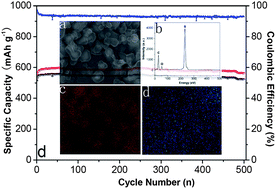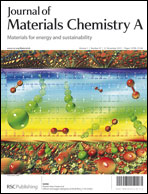Graphene-encapsulated sulfur (GES) composites with a core–shell structure as superior cathode materials for lithium–sulfur batteries†
Abstract
Relatively uniform sized graphene-encapsulated sulphur (GES) composites with a core (S)–shell (graphene) structure were synthesized in one pot based on a solution-chemical reaction–deposition method. These novel GES particles were characterized by XRD, Raman spectrometry, SEM, TGA, EDS and TEM. The electrochemical tests showed that the present GES composites exhibit high specific capacity, good discharge capacity retention and superior rate capability when they were employed as cathodes in rechargeable Li–S cells. A high sulphur content (83.3 wt%) was obtained in the GES composites. Stable discharge capacities of about 900, 650, 540 and 480 mA h g−1 were achieved at 0.75, 2.0, 3.0 and 6.0 C, respectively. The good electrochemical performance is attributed to the high electrical conductivity of the graphene, the reasonable particle size of sulphur particles, and the core–shell structures that have synergistic effects on facilitating good transport of electrons from the poorly conducting sulphur, preserving fast transport of lithium ions to the encapsulated sulphur particles, and alleviating the polysulfide shuttle phenomenon. The present finding may provide a significant contribution to the enhancement of cathodes for the lithium–sulphur battery technology.


 Please wait while we load your content...
Please wait while we load your content...